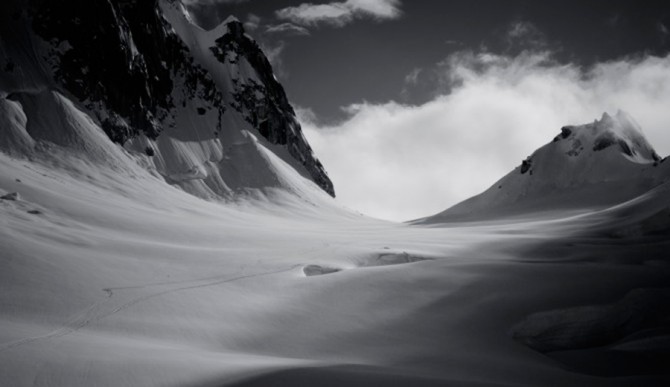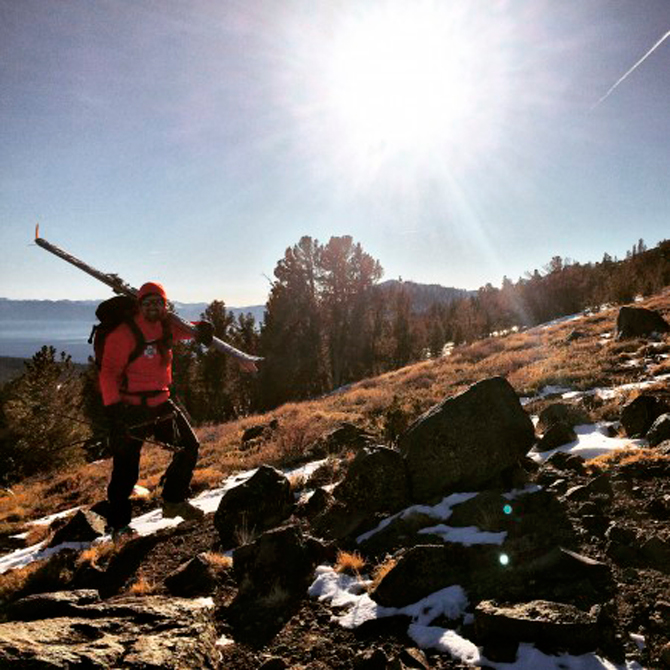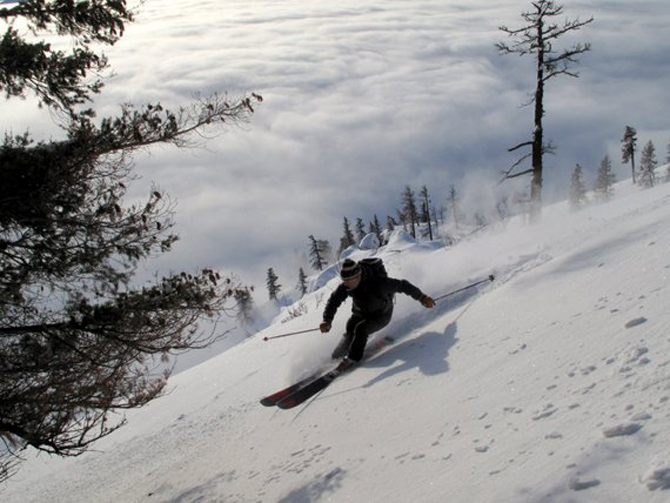
Photo: Spencer James.
Since this series began a couple months ago, not much has changed with respect to snow conditions here on the west coast. In Berkeley, where I live, each day feels more like summer as the warm sun that everyone in the city adores continues to drain the Sierra snowpack.

The warm, dry winter has been extremely tough on the Sierra’s snowpack. This photo from the last weekend in January shows how one must ascend the southern ridgeline of Tamarack Peak, a popular backcountry ski destination near Mt. Rose. Photo: Ian Bolliger
I receive the Sierra Avalanche Center forecast daily into my inbox and every time it reads like a carbon copy of the previous one: “low avalanche danger at all elevations; beware of wet loose slides on sun-exposed aspects.” It is essentially a late spring snowpack, after free water has percolated throughout the entire thing and removed significant layers to leave one isothermic block of mush. Melt-freeze cycles lead to firm conditions in the early mornings that give way to some decent corn in the late morning.

A Sierra Avalanche Center daily forecast typical of the past few months. With consistently warm and dry weather, the snowpack has changed very little.
For kicks, let’s imagine that a weak cold front were to come in on top of this snowpack, dropping an inch or two of low density snow on top of a shallow frozen layer. If you were to go on a tour after this storm, you would likely encounter places where you can float on top of the new snow without even noticing the hidden crust below. In other locations, you might consistently scrape your edges on the subsurface ice. The lack of certainty about what you will feel when you initiate a turn or drop into a line is what makes these mixed snow types particularly tough to navigate and is the reason I saved these conditions for last. Using a combination of approaches applicable to purely soft or hard snow types, it is possible to navigate mixed conditions safely; however, it requires an understanding of the nature of the conditions you are faced with.
Thus, here of three of the most common mixed snow types, as well as some advice on how to approach each of them.

Dust on crust is often hard to visually distinguish from regular powder, yet shallow arcs left by a skier are one sign. On the other hand, the harsh scraping sound is usually a pretty hard-to-miss auditory sign… Photo: Colin Haley
Dust on Crust – A shallow layer of low density snow atop a smooth crust.
Skill level: Advanced
Forms by: Cold fronts on top of a snowpack capped by a crust layer. The crust could be formed by any mechanism, typically either a diurnal melt-freeze cycle or a rain event followed by colder temperatures. It’s common to find dust on crust in the early spring, when clear and sunny periods are broken up by periodic storms that drop several inches to a foot of new snow.
Pros: It can feel just like your average pow day in some spots if you are light enough on your feet and the dusting is deep enough.
Cons: It’s unpredictable. Not knowing what you will feel going into the initiation of a turn can cause tentativeness and a tendency to sit back on the tails of your skis. That weight transition, combined with the jarring sensation of hitting the firm layer, can throw you off balance and send you for a cartwheel. Additionally, you typically can’t enjoy the carefree, floating feeling associated with deeper powder because you are always focused on being prepared to hit the crust. Finally, if the dusting is significant enough and bonds poorly to the underlying crust, you may find yourself in the sweet spot for storm slab avalanches.
Best approach: Ensure that the terrain you are traveling in is safe with respect to storm slabs. When skiing, try to stay as light on your feet as possible. The more force you exert at the apex of your turns, the deeper your skis penetrate and the more likely you are to hit that crust. Avoiding this means lengthening your turns, keeping your movements fluid, and gradually weighting and unweighting your skis. Finesse is your friend in this case and will also prepare you to better absorb the impact if you do wind up finding the firm layer. Fatter skis will help you here too, as they will disperse your weight and cause you to sink less.
Powder on Chicken Heads – The analog of “dust on crust” when the underlying layer consists of chicken heads or death cookies, rather than a smooth crust.
Skill level: Expert
Forms by: Same mechanisms as dust on crust, with a different underlying layer.
Pros: I’ve been trying to think of one for a while… Let me know if you come up with something.
Cons: Quite possibly the worst conditions you can encounter in the backcountry. If there is enough new snow, it will hide the irregularities in the surface of the crust layer, potentially obscuring large obstacles from your sight until they emerge as a wall for your skis and a vault for your body. I’ve seen skis broken when their owner crashed into a boulder-sized block hidden beneath a recent dusting. These conditions create a high potential for faceplants and or significant leg injuries.
Best approach: Take it slow, but not uber-slow. The faster you go, the less time you will have to react to obstacles that you can see, but the more likely you will be to ride on top of buried landmines. Skis with significant rocker will help a lot in these conditions, as they will carry your tips up and over those boulders that might destroy cambered boards.
*In the above video by Russell Hartwig, we see how a hidden, uneven surface can lead to unpredictable turns and can make it easy to catch a tip.

A skier manages to stay on top, or at least near the top, of a breakable crust layer on Twin Peaks in Washington State. Photo: Andy Dappen
Breakable Crust – A thin crust capping a less consolidated layer, which sometimes supports your weight and sometimes does not
Skill level: Expert
Forms by: Near freezing conditions that dip below the threshold for a brief period of time. Any mechanism that can form a crust can form a breakable crust if the duration of those conditions is relatively short. In essence, a breakable crust is the inverse of “dust on crust”.
Pros: Like with dust on crust, if you can stay on top of it, you will find a relatively smooth ride. The terminology for conditions in which you can consistently ride on top is “supportable crust.” Of course, what’s supportable for a 130 lb. female skier is not necessarily supportable for a 220 lb. male…
Cons: Like the conditions discussed above, breakable crusts add an element of unpredictability to each turn, especially if the crust is not breakable everywhere. In this case, you are never quite sure when you will transition from firm, fast skiing to sinking down into the unconsolidated snow below. When you do break through, you now must plow that crust layer using your boots as an icebreaker. This sudden addition of force causes you to lurch forward and can often initiate a few somersaults. Due to this phenomenon, I would say that breakable crusts are the conditions most likely to make you feel (and look) like you just learned to ski yesterday.
Best approach: As always, stay balanced. Keep an upright stance and avoid leaning forward with your upper body. This lean puts you in a prime pre-somersault position. As with the aforementioned snow types, stay light on your feet to minimize the amount of time that you spend beneath the crust, if possible. Fast, large radius turns are your ally. The large radius will minimize the downward force you exert on the fragile layer and the speed will allow you to plow through the layer when you do (inevitably) break through it.
These three mixed snow types round out my discussion of snow conditions commonly encountered in the backcountry. Of course, they are just a select sample of the entirety of snow conditions that exist and my decision as to the “most common” conditions is undoubtedly biased by having called the west coast home for most of my life. Additionally, no two snow conditions are ever the same. The snow type we see lies on a multidimensional spectrum involving water content, crystal size, and crystal shape among other factors. It is convenient for us to classify conditions into specific types but beware that many snow types may cross these arbitrarily distinctive boundaries. All that aside, I hope that these last few posts have proved valuable for those of you seeking to venture out past the confines of a resort for the first time and have served as a refresher for those of you that have faced all of these conditions numerous times before.
Stay safe and keep adventuring!
Be sure to read the Part 1 and 2 of Backcountry Essentials with Backcountry Essentials, Part 1: Hard Snow Conditions and Backcountry Essentials, Part 2: Soft Snow Conditions. Also, don’t forget to catch up on planning out your days with How to Read Weather Forecasts During Snow Season.

